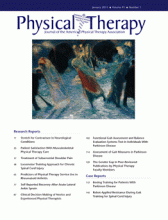Abstract
Background Although physical therapy is a proven and recommended intervention for managing rheumatoid arthritis (RA), few studies have explored correlates of physical therapy service use among people with RA.
Objective The purposes of this study were: (1) to describe physical therapy use among people with RA and (2) to identify biopsychosocial factors associated with physical therapy use. It was expected that use of physical therapy services would be lower than previously reported, considering recent medical advancements, and that including contextual factors may lead to identification of new factors associated with physical therapy use.
Design This was a cohort study.
Methods Of 1,032 patients prospectively recruited from a large hospital registry, 772 completed baseline and laboratory assessments, received a physical examination, and completed a 1-year follow-up survey regarding physical therapy service use. Measures included: demographics (ie, age, sex, marital status, race, employment, disability status, insurance, income, comorbidities, and education), disease duration, RA medications, self-efficacy (assessed with the Arthritis Self-Efficacy Scale), social support (assessed with the Berkman-Syme Social Network Index), function (assessed with the Multi-Dimensional Health Assessment Questionnaire), and disease activity (assessed with the Rheumatoid Arthritis Disease Activity Index). Self-reported use of physical therapy (yes/no) was assessed at the 1-year follow-up. A staged regression approach, based on a theoretical model, was used to select and enter variables into the regression to develop a parsimonious set of predictors.
Results The patients were well educated and had modestly high incomes, and most had health insurance. Approximately 15.3% of the patients used physical therapy services during the designated follow-up period. Using multivariable modeling, the most significant predictors of physical therapy service use were moderate to high disease activity (odds ratio [OR]=1.4, 95% confidence interval [CI]=1.1–1.8), less than a college education (OR=0.5, 95% CI=0.2–0.8), greater social networks (OR=2.1, 95% CI=1.3–3.5), and being on disability (OR=2.4, 95% CI=1.3–4.6).
Limitations The limitations of this study were use of a convenience sample and the potential for misclassification of physical therapy service use.
Conclusions Patients with less than college education were less likely to receive physical therapy services, and those with more active disease, those who were on disability, and those who had greater social networks were more likely to receive physical therapy services.
Footnotes
Dr Iversen and Dr Shadick provided concept/idea/research design and data collection. All authors provided writing. Dr Iversen and Dr Chhabriya provided data analysis. Dr Iversen provided institutional liaisons. Dr Shadick provided fund procurement, participants, facilities/equipment, and consultation (including review of manuscript prior to submission).
The study was undertaken following human subjects approval from Brigham & Women's Hospital and complied with the ethical rules for human experimentation stated in the Declaration of Helsinki.
The registry of patients with rheumatoid arthritis used in this study is funded by Biogen and Crescendo Bioscience.
- Received June 1, 2009.
- Accepted September 3, 2010.












